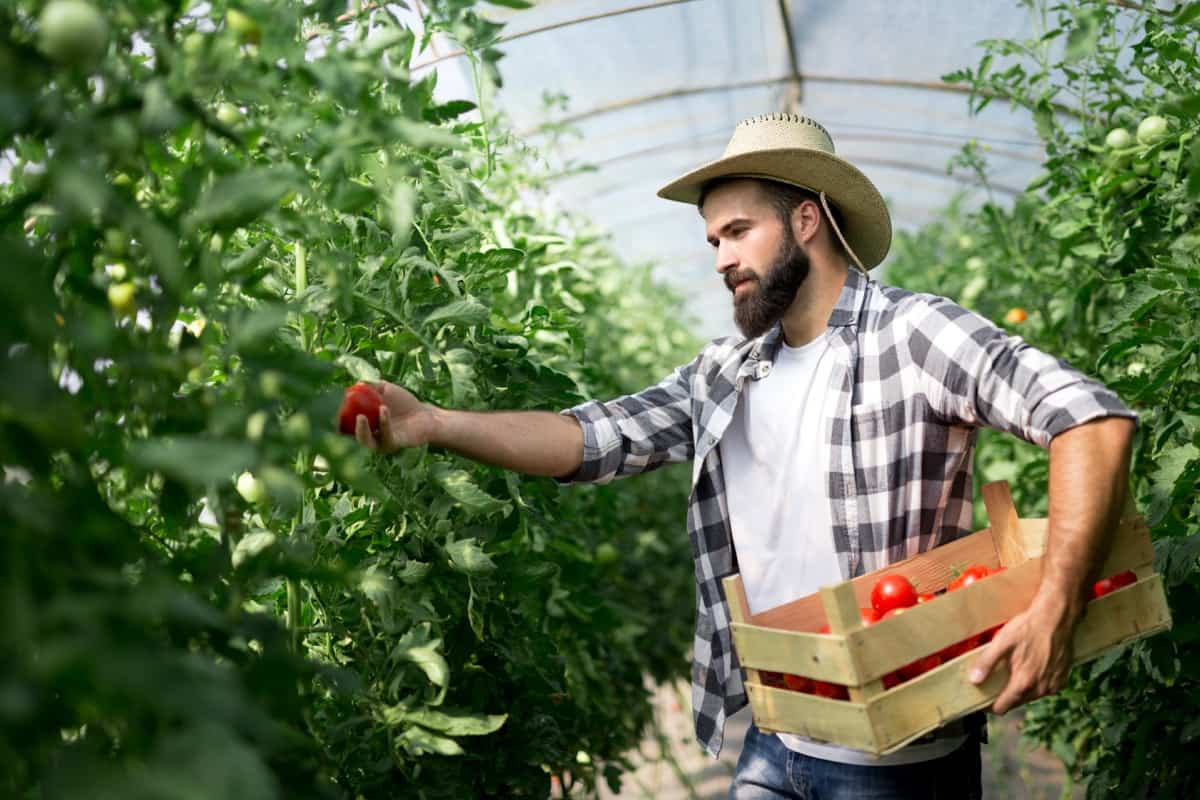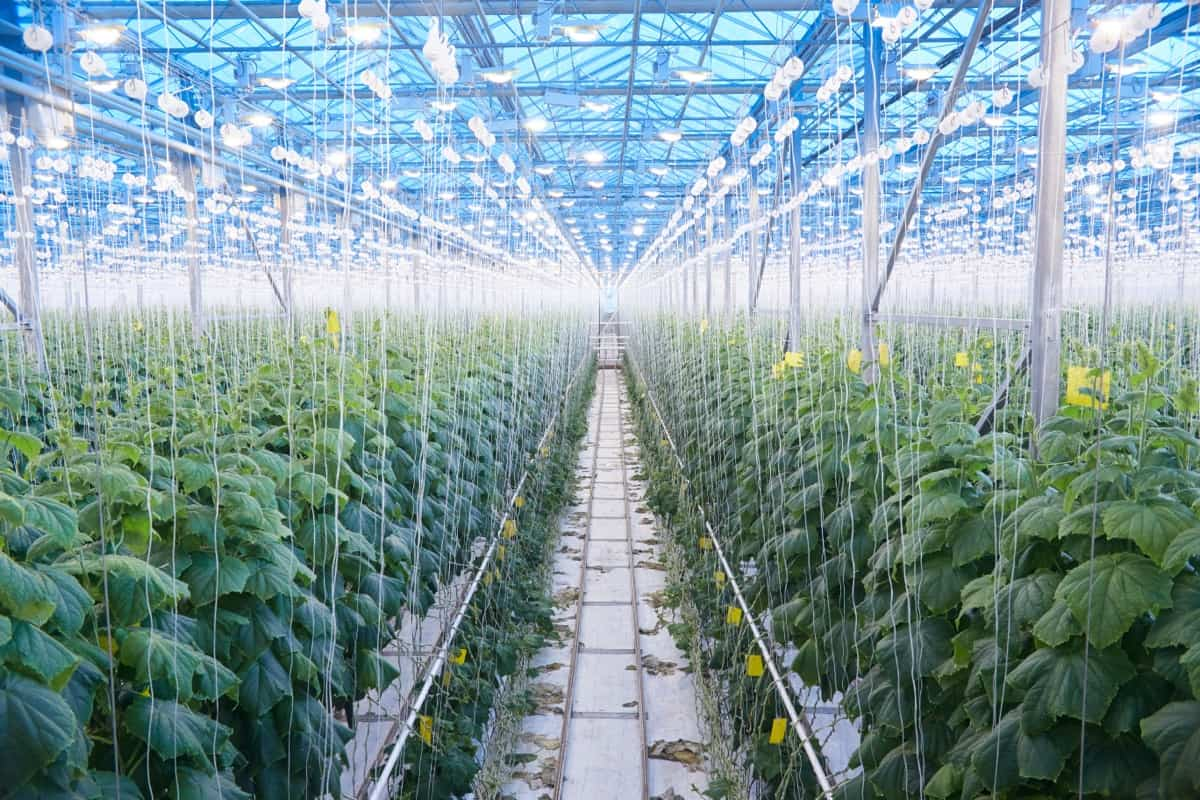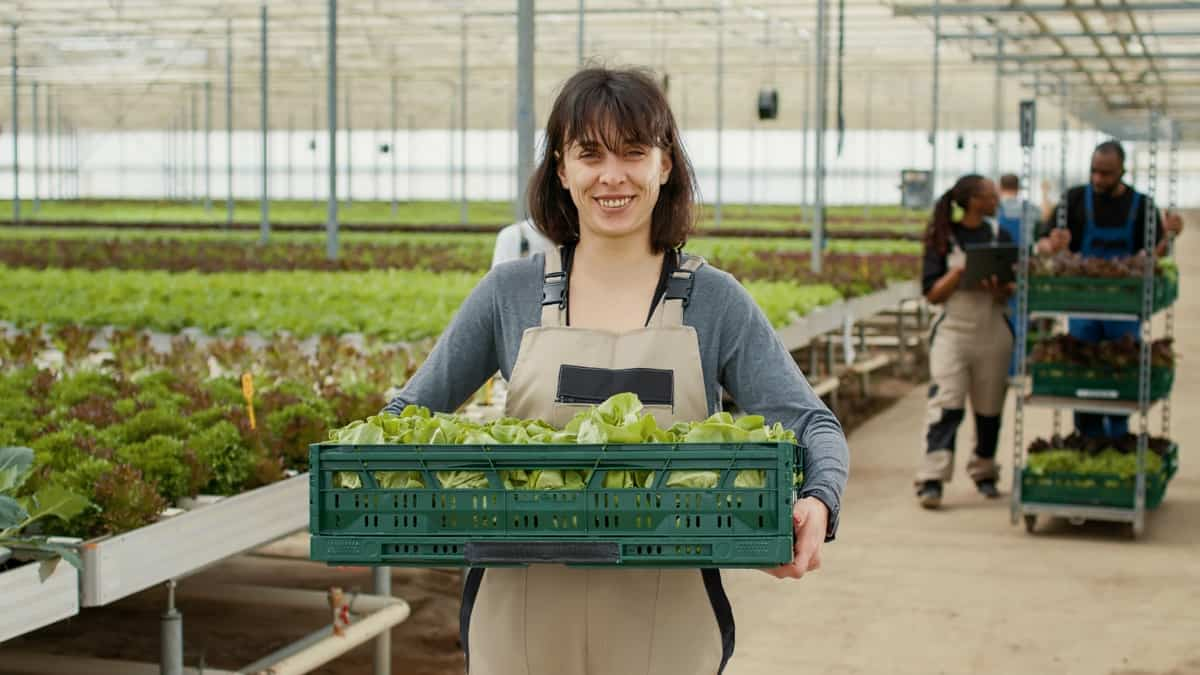Greenhouse farming is a modern practice of agriculture where crops are grown within sheltered transparent material. Greenhouse farming in Maharashtra is done extensively because of the state’s tropical climate and ideal soil conditions. Greenhouse farming is the technique of providing favorable environmental conditions to plants.

Greenhouse Farming in Maharashtra
What is Greenhouse Farming?
Greenhouse farming is a type of agriculture where crops are grown in an enclosed environment. Greenhouses can be made of different materials, but they all aim to create a controlled environment ideal for plant growth. In Maharashtra, greenhouse farming is becoming increasingly popular due to the state’s large agricultural industry. Greenhouses offer farmers the ability to grow crops year-round, as well as control the temperature and humidity levels within the structure. This allows for more consistent crop yields and higher-quality produce.
How to Start Greenhouse Farming?
Greenhouse farming requires heavy expenditure on infrastructure, equipment, labor, and raw material. A greenhouse farmer must have technical, economic, and marketing knowledge to succeed. Maharashtra is suited for greenhouse farming due to its climate and geographical features. The state has a tropical climate with average temperatures ranging from 20-25°C. Maharashtra also has a long coastline which gives it access to a large amount of sunlight. Additionally, the state receives adequate rainfall, which is necessary for greenhouse farming.
Greenhouse Vegetable Production in Maharashtra
Maharashtra is one of the leading states for greenhouse vegetable production in India. The state accounts for 18% of India’s total greenhouse vegetable production. The primary crops grown in greenhouses in Maharashtra include Tomatoes, Cucumbers, Peppers, and Eggplants. These crops are all well-suited to the climate conditions found in the state and can be grown year-round using greenhouse cultivation methods.
In case you missed it: Greenhouse Farming in Karnataka: Crops, 1 Acre Greenhouse Cost, Subsidy, and Loans

Benefits of Greenhouse Farming in Maharashtra
The benefits of greenhouse farming include controlling the environment inside the structure, which can lead to higher yields and earlier harvests. In addition, greenhouses can protect from extreme weather conditions and pests and extend the growing season for certain crops. Greenhouse farming is also relatively water-efficient, as irrigation systems can be better controlled in a closed environment.
Greenhouse farming in Maharashtra can provide several benefits for farmers. The state has a tropical climate, ideal for growing various crops. Greenhouse farming can protect crops from extreme weather conditions, pests, and diseases. They can also extend the growing season and increase yields. The main advantage of greenhouse farming in Maharashtra is the production of crops all year round. This is because the temperature and humidity levels are well suited for greenhouse cultivation.
Farmers do not have to rely on weather patterns to produce their crops. They can control the environment inside the greenhouse to provide optimal conditions for plant growth. Another advantage of greenhouse farming in Maharashtra is that it protects crops from pests and diseases. The controlled environment inside a greenhouse does not allow pests or diseases to spread, which results in healthier plants and higher yields.
In case you missed it: How to Build a Small Greenhouse from Scratch: Cheap Construction Ideas, Material Required, and Setup Cost

Is Greenhouse Farming Profitable in Maharashtra?
Greenhouse farming is a type of agriculture where crops are grown in structures with controlled environmental conditions. In India, greenhouse farming is gaining popularity as it offers several advantages over traditional farming methods. Maharashtra is the leading state in India for greenhouse cultivation. The state has a favorable climate for greenhouse farming, and many farmers are adopting this cultivation method.
How Does Greenhouse Farming Work in Maharashtra?
Greenhouse farming is a type of agriculture where crops are grown in protected environments. Greenhouses are typically made of transparent plastic or glass, allowing sunlight to enter and warm the plants inside. This controlled environment can provide optimal crop growth conditions and protect them from pests and diseases. In Maharashtra, greenhouse farming is practiced extensively for various crops, including tomatoes, cucumbers, peppers, and flowers. The state government has provided subsidies and loans to encourage farmers to set up greenhouses.
Crops are Grown Under Greenhouses in Maharashtra
Greenhouse farming can be used to grow a wide variety of crops, including vegetables, fruits, and flowers. Once your greenhouse is up and running, you can start growing various crops. Maharashtra’s most popular choices include tomatoes, cucumbers, peppers, and eggplants. With proper care and management, your greenhouse farm can yield high quantities of fresh produce that you can sell at local markets or even export to other parts of India and beyond.
Some crops grown in greenhouses in Maharashtra include tomatoes, cucumbers, capsicums, chilies, and gherkins. These crops are grown throughout the year, irrespective of the season. This ensures a steady supply of these vegetables to the market and reduces dependence on imports from other states.
What are the Different Types of Greenhouse Farms in Maharashtra?
- Open-field greenhouses are the most common type of greenhouse in the state and are used for many crops.
- Net houses are used for crops that require more protection from the elements, such as delicate fruits and vegetables.
- Shade houses provide shelter from the sun for heat-sensitive crops like tobacco.
In case you missed it: How to Use Mineral Oils in Garden: Tips, Steps, and Application

Greenhouse Set-Up Cost in Maharashtra
Greenhouse farming in Maharashtra is a popular and lucrative option for farmers. The state government provides subsidies and loans to encourage greenhouse farming. The average cost of setting up a 1-acre greenhouse in Maharashtra is Rs. 2 to 8 lakhs. The cost includes construction, materials, equipment, and labor.
Tips to Start Greenhouse Farming in Maharashtra
- You’ll need to ensure your greenhouses are properly ventilated and receive enough sunlight.
- You’ll also need to have a reliable water source, as well as an irrigation system in place.
- Finally, you’ll need to select the right crops for your climate and soil type.
- With careful planning and execution, greenhouse farming can be a great way to produce fresh, healthy food for yourself and your community.
Can You Grow in a Greenhouse Year-Round in Maharashtra?
Yes, you can grow in a greenhouse year-round in Maharashtra. The moderate climate of Maharashtra is ideal for greenhouse farming. The average temperature in Maharashtra ranges from 20-25°C. This makes it possible to grow various crops in a greenhouse throughout the year.
Greenhouse Farming Areas in Maharashtra
Greenhouse farming in Maharashtra is mostly concentrated in the Vidarbha and Marathwada regions. In Vidarbha, greenhouse farming is done on a large scale in Yavatmal, Amravati, and Akola districts. In Marathwada, it is done on a smaller scale in Aurangabad, Nanded, and Latur districts.
In case you missed it: How to Grow Grapes Organically in Maharashtra: Step-By-Step Cultivation Process and Production Management

Create a Greenhouse Business Plan in Maharashtra
- Location is an important factor in starting greenhouse farming in Maharashtra. Choosing a location that receives adequate sunlight and has good drainage is important.
- Decide on the type of greenhouse that you want to build. There are different types of greenhouses available in the market, so choose the one that best suits your needs.
- Then, it would help if you created a business plan. This gives you a clear idea of how much money you need to invest in the business and what all things need to be taken care of.
- The next step is selecting the type of greenhouse you want to set up. Various greenhouses are available in the market, and you must select one according to your budget and requirement.
- Greenhouses come in various sizes, so it is important to select a size that is appropriate for the amount of space available and the needs of the farm.
- After selecting the type of greenhouse, the next step is to select the site for setting up the greenhouse. The site must have enough space for the structure and future expansion.
- Once you have selected the site, the next step is to get all the necessary approvals from the concerned authorities. This includes approval from Local Development Authority (LDA) and the fire department.
- Once all the approvals are in place, the next step is to start construction of the greenhouse. You will need to hire a good contractor with experience constructing greenhouses.
- After the greenhouse construction, the next step is installing all the necessary equipment.
- Decide what plants you want to grow in your greenhouse. Research their requirements and choose accordingly.
- Estimate the cost of all the materials that you will need to start your greenhouse business. Include one-time and recurring costs, such as electricity and water bills, etc., in your estimate.
- Find out about government regulations regarding setting up greenhouses in Maharashtra. Before starting your business, comply with all the rules and regulations.
Greenhouse Subsidies and Loans Available in Maharashtra
Greenhouse systems incorporate farming activities related to floriculture and the horticulture sector. Several banks provide loans for setting up greenhouse systems. The cost of setting up a greenhouse varies depending on the farm size and type of structure. However, it is important to note that greenhouse farming is capital-intensive. As such, you will need to take out a loan or access other financial assistance to start.
In case you missed it: Ways to Use Neem Oil in Plants: Benefits in Agriculture, Application Method in Garden, and Uses in Hydroponics

The government of Maharashtra offers subsidies for those who wish to set up greenhouses, making this option more affordable. The state government offers a subsidy of 50% for the construction of greenhouses. The maximum subsidy amount is Rs. 1 lakh per hectare. Farmers can avail of this subsidy by applying for it through the Department of Agriculture. In addition, the state government also provides loans for the construction of greenhouses at an interest rate of 7%.
- The construction cost of a 200 square meters greenhouse is Rs. 4 lakhs. The farmer is eligible for a subsidy of 50% of the set-up cost, subject to a maximum of Rs. 2 lakhs.
- A subsidy of 50% is provided for establishing a nursery, subject to a maximum limit of Rs. 20,000 per hectare.
- A subsidy of 30% is provided for the purchase of equipment used in greenhouse farming, subject to a maximum limit of Rs. 1 lakh per farmer.
- The State Government of Maharashtra provides a subsidy of 50% on the cost of setting up a greenhouse, subject to a maximum limit of Rs. 1 lakh.
- The NABARD (National Bank for Agriculture and Rural Development) provides loans for the construction of greenhouses at preferential interest rates.
- The Central government’s Ministry of Agriculture and Farmers Welfare provides financial assistance to states under the National Mission on Agricultural Extension and Technology (NMAET) scheme. This scheme includes a component for establishing demonstration units, which farmers can use to get acquainted with greenhouse technology.
Points to Consider Before Selecting a Greenhouse Site
- Soil pH should be between 5.5 to 6.5 and EC (Volatility) 0.3 to 0.5 mm/cm.
- ·Good water quality is available continuously.
- The irrigation water samples should range from pH level 5.5 to 7.0 and EC 0.1 to 0.3
- The selected location should be pollution-free.
- There must be roads for the transportation and shipping goods in the market.
- The place must be large enough for the upcoming expansion.
- Workers must be available easily.
- There must be excellent communication facilities in place.
- The drainage of the soil must be excellent.
Challenges of Greenhouse Farming in Maharashtra
- One of the key challenges of greenhouse farming in Maharashtra is the lack of reliable and affordable electricity. Many farmers have to rely on diesel generators to power their greenhouses, which can be expensive and difficult to maintain.
- Another challenge is the limited availability of water. Many farmers have to rely on borewells or tanker trucks to get water for their crops, which can be costly and unreliable.
- Finally, pests and diseases are major problems in greenhouse agriculture. Farmers must constantly battle against fungal diseases, insect infestations, and other pests that can destroy their crops.
In case you missed it: District Wise Crop Production in Maharashtra: Major Crops in Maharashtra

Conclusion
A Greenhouse is a framed structure with a transparent material large enough to grow several crops under partial or fully controlled environmental conditions for optimum growth and productivity. It’s also becoming an attractive option for farmers as the government provides various subsidies and loans for setting up greenhouses. If you are planning for Greenhouse farming in the following districts of Maharashtra, the above blog post will help with the basics of Greenhouse agriculture/cultivation.
| Ahmednagar | Nagpur |
| Akola | Nanded |
| Amravati | Nandurbar |
| Aurangabad | Nashik |
| Beed | Osmanabad |
| Bhandara | Palghar |
| Buldhana | Parbhani |
| Chandrapur | Pune |
| Dhule | Raigad |
| Gadchiroli | Ratnagiri |
| Gondia | Sangli |
| Hingoli | Satara |
| Jalgaon | Sindhudurg |
| Jalna | Solapur |
| Kolhapur | Thane |
| Latur | Wardha |
| Mumbai City | Washim |
| Mumbai Suburban | Yavatmal |
- Goat Farming Technology: The Future of Goat Husbandry
- How to Build a Low-budget Goat Shed: Cheap Ideas and Tips
- Goat Farming Training Programs in India: A Beginner’s Guide
- Types of Pesticides Used in Agriculture: A Beginner’s Guide
- Economical Aquaculture: A Guide to Low-Budget Fish Farming
- 15 Common Planting Errors That Can Doom Your Fruit Trees
- How to Make Houseplants Bushy: Effective Tips and Ideas
- Innovative Strategies for Boosting Coconut Pollination and Yield
- Pollination Strategies for Maximum Pumpkin Yield
- The Complete Guide to Chicken Fattening: Strategies for Maximum Growth
- Natural Solutions for Tulip Problems: 100% Effective Remedies for Leaf and Bulb-Related Issues
- Revolutionizing Citrus Preservation: Towards a Healthier, Greener Future
- Natural Solutions for Peony Leaf and Flower Problems: 100% Effective Remedies
- Maximizing Profits with Avocado Contract Farming in India: A Comprehensive Guide
- Natural Solutions for Hydrangea Problems: 100% Effective Remedies for Leaf and Flowers
- The Ultimate Guide to Choosing the Perfect Foliage Friend: Bringing Life Indoors
- From Sunlight to Sustainability: 15 Ways to Use Solar Technology in Agriculture
- The Ultimate Guide to Dong Tao Chicken: Exploring from History to Raising
- The Eco-Friendly Makeover: How to Convert Your Unused Swimming Pool into a Fish Pond
- Mastering the Art of Delaware Chicken Farming: Essentials for Healthy Backyard Flocks
- 20 Best Homemade Fertilizers for Money Plant: DIY Recipes and Application Methods
- How to Craft a Comprehensive Free-Range Chicken Farming Business Plan
- Brighten Your Flock: Raising Easter Egger Chickens for Beauty and Bounty
- How to Optimize Your Poultry Egg Farm Business Plan with These Strategies
- Subsidy for Spirulina Cultivation: How Indian Government Schemes Encouraging Spirulina Farmers
- Ultimate Guide to Raising Dominique Chickens: Breeding, Feeding, Egg-Production, and Care
- Mastering the Art of Raising Jersey Giant Chickens: Care, Feeding, and More
- Ultimate Guide to Raising Legbar Chickens: Breeding, Farming Practices, Diet, Egg-Production
- How to Raise Welsummer Chickens: A Comprehensive Guide for Beginners
- How to Protect Indoor Plants in Winter: A Comprehensive Guide
- Ultimate Guide to Grow Bag Gardening: Tips, Tricks, and Planting Ideas for Urban Gardeners
- Guide to Lotus Cultivation: How to Propagate, Plant, Grow, Care, Cost, and Profit
- Agriculture Drone Subsidy Scheme: Government Kisan Subsidy, License, and How to Apply Online
- Ultimate Guide to Raising Araucana Chickens: Breed Profile, Farming Economics, Diet, and Care
- Bringing Hydroponics to Classroom: Importance, Benefits of Learning for School Students
- Ultimate Guide to Raising Polish Chickens: Breed Profile, Farming Economics, Diet, and Care